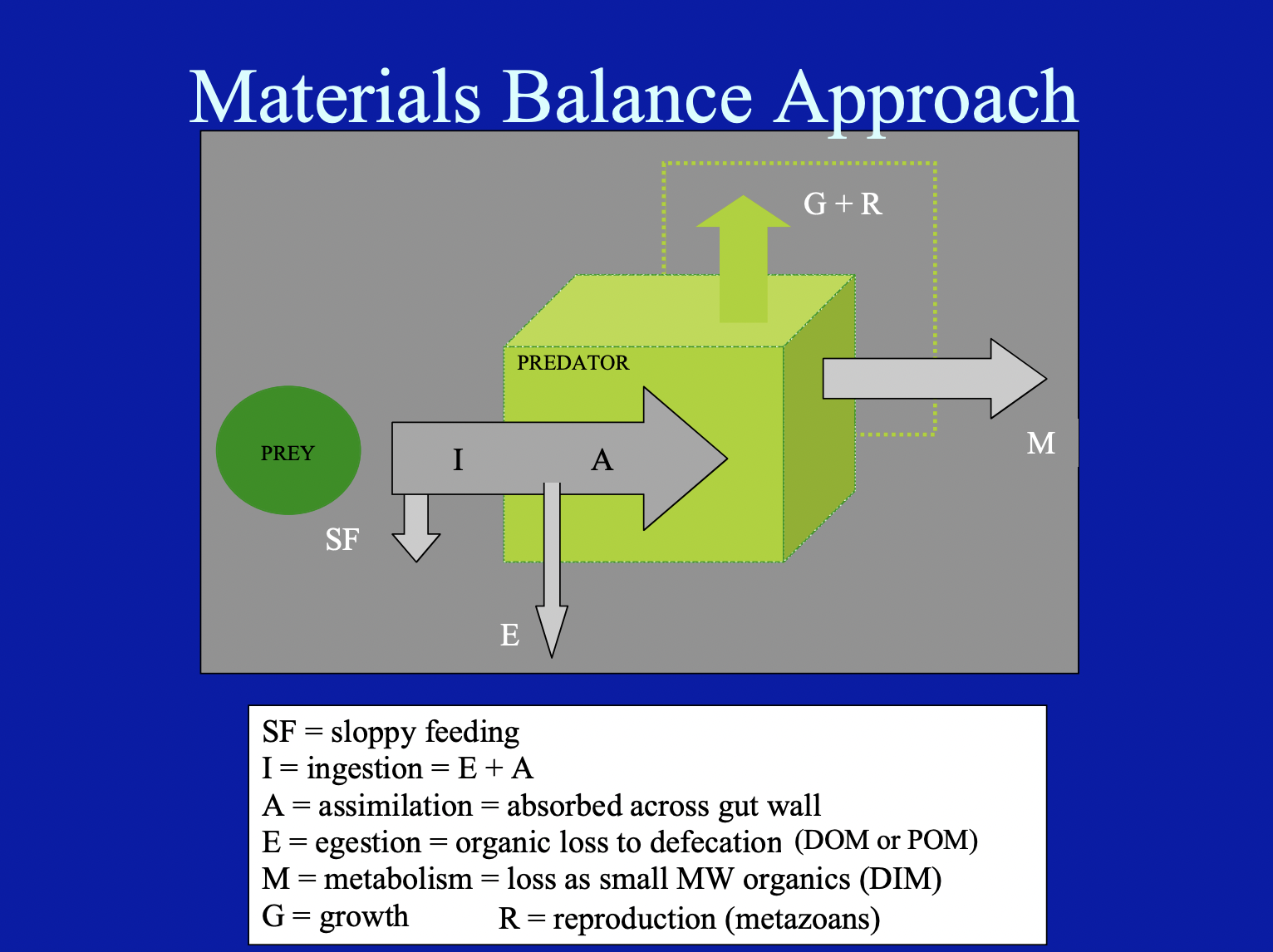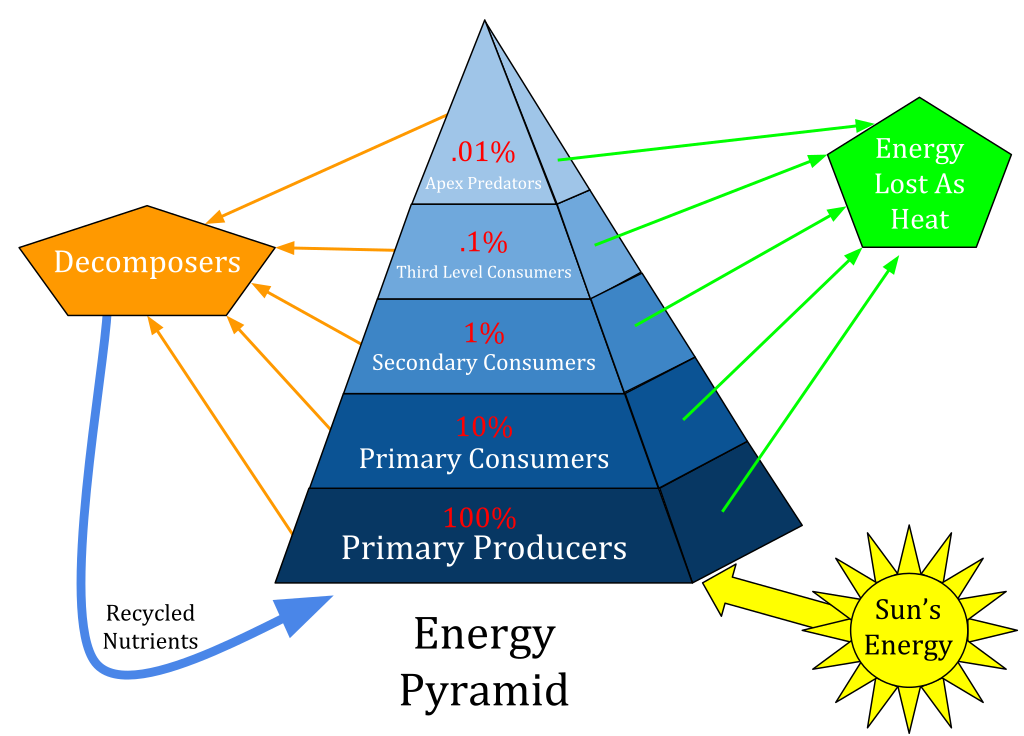IB Syllabus focus:
‘Consumer biomass gain from assimilated food; equals ingested food minus faecal waste. Units match primary productivity; faeces excluded as undigested/unabsorbed material.’
Secondary productivity is a central concept in ecology, showing how energy passes from producers to consumers. It measures the actual growth and energy retention of heterotrophs within ecosystems.
Defining Secondary Productivity
Secondary productivity refers to the rate at which consumers (heterotrophs) convert ingested food into new biomass through growth and reproduction. Unlike primary productivity, which concerns producers and photosynthesis, secondary productivity captures the efficiency of energy transfer in consumer populations.
Secondary Productivity: The rate of biomass gain in consumer organisms, measured as assimilated food minus faecal waste, typically expressed in kg C m⁻² yr⁻¹.
This measurement excludes faecal matter because faeces represent undigested or unabsorbed material, not available for biomass assimilation.
Components of Secondary Productivity
The process of calculating secondary productivity involves breaking down consumer feeding into several measurable flows:
Ingested food (I): All food consumed by the organism.
Faecal waste (F): Undigested and egested material, not absorbed into the body.
Assimilated food (A): The portion of ingested food absorbed through digestion (I – F).
Respiration losses (R): Energy expended on metabolism and maintenance.
Biomass gain (P): The fraction of assimilated food that contributes to growth and reproduction.
Secondary Productivity (P) = Ingested Food (I) – Faecal Waste (F) – Respiration (R)
I = Total food consumed (kJ or kg C m⁻² yr⁻¹)
F = Undigested material, lost as faeces (same units)
R = Energy lost through respiration and maintenance (same units)
Thus, secondary productivity represents the net growth of consumer biomass within a given time and area.
Secondary productivity is determined by the consumer energy budget: ingested food (I) is split into faecal losses (F) and assimilated energy (A), which is then partitioned into respiration (R) and production (growth + reproduction).

Diagram of a consumer’s energy budget showing ingestion (I), faecal egestion (E/F), assimilation (A), metabolic/respiratory loss (M/R), and production (G + R). This directly illustrates GSP = I − F and NSP = GSP − R used to quantify secondary productivity. Labels align with standard ecological energetics terminology. Source.
Primary vs Secondary Productivity
Primary Productivity
Conducted by autotrophs (plants, algae, some bacteria).
Relies on photosynthesis or chemosynthesis.
Provides the base of food chains.
Secondary Productivity
Conducted by heterotrophs (herbivores, carnivores, omnivores, detritivores).
Relies on consuming organic matter from other organisms.
Reflects how efficiently energy is transferred up trophic levels.
Both are expressed in the same units (kg C m⁻² yr⁻¹), allowing for direct comparison of energy flow efficiency across trophic levels.
Factors Affecting Secondary Productivity
Abiotic Factors
Temperature: Influences metabolic rate and thus assimilation efficiency.
Oxygen availability: Critical for aerobic respiration, which underpins growth.
Water availability: Affects digestion and nutrient absorption.
Biotic Factors
Food quality: High-protein and high-energy foods improve assimilation efficiency.
Food availability: Abundant food enhances growth rates.
Trophic level: Carnivores generally show higher assimilation efficiency than herbivores because animal tissue is easier to digest than cellulose.
Types of Secondary Productivity
Secondary productivity can be categorised into gross secondary productivity (GSP) and net secondary productivity (NSP):
Gross Secondary Productivity (GSP): The total energy or biomass assimilated by consumers after subtracting faecal losses from ingestion.
Net Secondary Productivity (NSP): The portion of assimilated energy available for growth and reproduction after accounting for respiration losses.
NSP = GSP – Respiration (R)
This distinction is crucial because only NSP reflects the actual contribution of consumer biomass to higher trophic levels.
Measuring Secondary Productivity
Field and laboratory methods provide ways to quantify secondary productivity:
Feeding trials: Controlled environments where ingestion, faecal waste, and respiration are measured.
Energy budget analysis: Calculates productivity through tracking input (food) and output (waste, respiration, growth).
Population growth studies: Observes biomass increase over time within populations.
All approaches aim to link food intake with measurable biomass accumulation.
Ecological Significance
Secondary productivity is central for understanding food web dynamics:
Determines how much energy moves from producers to consumers.
Explains why higher trophic levels contain fewer individuals and less biomass.
Informs models of ecological efficiency, often simplified as the “10% rule” (though actual efficiency varies widely).
Shapes human practices such as fisheries management, livestock farming, and conservation, where secondary productivity estimates guide sustainable harvesting.
Because energy is lost as heat in respiration at every transfer, progressively less energy is available to consumers at higher trophic levels.

An ecological energy pyramid showing decreasing energy from producers to higher-level consumers, reflecting transfer inefficiencies that constrain net secondary productivity at upper levels. The pyramid format reinforces the link between respiration losses and reduced biomass gain for consumers. Although generic, it directly supports the syllabus focus on secondary productivity and trophic transfers. Source.
Key Points to Remember
Secondary productivity represents biomass gain by consumers through assimilation.
Faecal matter is excluded as it does not contribute to assimilation.
It is measured in the same units as primary productivity (kg C m⁻² yr⁻¹).
Two main categories: Gross Secondary Productivity (GSP) and Net Secondary Productivity (NSP).
Productivity levels vary by trophic level, food quality, and environmental conditions.
Understanding secondary productivity is essential for interpreting energy flow, ecosystem dynamics, and sustainability practices.
FAQ
Assimilation efficiency measures the percentage of ingested food that is absorbed by the digestive system, excluding faecal losses. It focuses on energy uptake during digestion.
Net secondary productivity (NSP), by contrast, considers growth and reproduction after accounting for energy lost in respiration. Assimilation efficiency is about energy absorption; NSP is about biomass gain.
Faecal waste contains undigested and unabsorbed material that never enters the consumer’s metabolic system. Including it would overestimate the energy actually available for growth.
Secondary productivity only considers assimilated energy, making the measure more accurate in reflecting how much biomass consumers can add to an ecosystem.
Consumers at higher trophic levels generally have higher assimilation efficiency, as animal tissue is easier to digest than cellulose.
However, the absolute energy available to them is smaller because much energy is lost at each trophic transfer. This results in lower net secondary productivity overall.
Respiration losses are often estimated indirectly through oxygen consumption in closed systems.
Measure oxygen uptake using respirometers.
Convert oxygen consumption into energy equivalents.
Subtract this from gross secondary productivity to estimate net secondary productivity.
Secondary productivity highlights inefficiencies in energy transfer at higher trophic levels.
Shifting human diets towards lower trophic levels, such as plant-based foods, reduces energy losses and supports higher yields.
In agriculture, monitoring secondary productivity in livestock helps determine feed efficiency, improving sustainability and reducing resource waste.
Practice Questions
Question 1 (2 marks):
Define net secondary productivity (NSP) and state how it is calculated.
Mark scheme:
Definition of NSP as the energy/biomass available for growth and reproduction in consumers after respiration losses are subtracted from assimilated energy. (1 mark)
Correct equation: NSP = GSP – R, where GSP is gross secondary productivity and R is respiration. (1 mark)
Question 2 (5 marks):
Discuss two factors, one abiotic and one biotic, that influence secondary productivity in consumer populations. Provide examples to support your answer.
Mark scheme:
Identification and explanation of an abiotic factor (e.g. temperature, oxygen availability, water availability) and how it affects assimilation or growth. (1–2 marks)
Identification and explanation of a biotic factor (e.g. food quality, food availability, trophic level) and its influence on assimilation efficiency or growth. (1–2 marks)
Use of relevant examples to illustrate the impact of both abiotic and biotic factors (e.g. carnivores assimilating more efficiently than herbivores due to easier digestion of animal tissue; high temperatures increasing metabolic demand). (1 mark)

